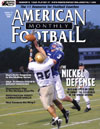AMERICAN FOOTBALL MONTHLY THE #1 RESOURCE FOR FOOTBALL COACHES
Article CategoriesAFM Magazine
|
Coaching Quarterbacks To Be Effective Runners in the Shotgun Zone Fly Offenseby: Bryon HamiltonHead Coach, Foothill High School, Palo Cedro (CA) © More from this issue The evolution of the quarterback from a true pocket passer to a passing / running hybrid is one of the most lethal offensive combinations that defenses have ever faced. A player that can beat you in the air and has the skill and confidence to beat you on the ground as well is what many of today’s best offensive coordinators are aggressively looking for. The Shotgun Zone Fly offense relies on this type of hybrid player. The success of the SZF run game, in large part, comes from the ability to spread the field while maintaining 2 to 3 run threats on every play. This would not be possible if the quarterback was not an effective part of the run game. Obviously, the natural running ability of the player at that position will be a factor in his success. But, how that player is prepared and what the coach emphasizes in practice will....The full article can only be seen by subscribers. Subscribe today!
|
|
|||||||
| HOME |
MAGAZINE |
SUBSCRIBE | ONLINE COLUMNISTS | COACHING VIDEOS |
Copyright 2025, AmericanFootballMonthly.com
All Rights Reserved





